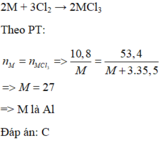Hãy nhập câu hỏi của bạn vào đây, nếu là tài khoản VIP, bạn sẽ được ưu tiên trả lời.

PT: \(2M+3Cl_2\underrightarrow{t^o}2MCl_3\)
\(n_M=\dfrac{10,8}{M_M}\left(mol\right)\), \(n_{MCl_3}=\dfrac{53,4}{M_M+35,5.3}\left(mol\right)\)
Theo PT: \(n_M=n_{MCl_3}\Rightarrow\dfrac{10,8}{M_M}=\dfrac{53,4}{M_M+35,5.3}\Rightarrow M_M=27\left(g/mol\right)\)
Vậy: M là Al.

\(PTHH:2R+xCl_2\xrightarrow{t^o}2RCl_x\\ \Rightarrow n_{R}=n_{RCl_x}\\ \Rightarrow \dfrac{10,8}{M_R}=\dfrac{53,4}{M_R+35,5x}\\ \Rightarrow 42,6M_R=383,4x\\ \Rightarrow M_R=9x\)
Thay \(x=3\Rightarrow M_R=27(g/mol)\)
Vậy R là nhôm (Al)

\(n_R=\dfrac{2,275}{M_R}\left(mol\right)\)
PTHH: R + Cl2 --to--> RCl2
___\(\dfrac{2,275}{M_R}\)---------->\(\dfrac{2,275}{M_R}\)
=> \(\dfrac{2,275}{M_R}\left(M_R+71\right)=4,76\)
=> MR = 65 (g/mol)
=> R là Zn

2M + 3Cl2 → 2MCl3
\(n_M=\dfrac{10,8}{M_M}\left(mol\right)\)
\(n_{MCl_3}=\dfrac{53,4}{M_M+106,5}\left(mol\right)\)
Theo PT: \(n_M=n_{MCl_3}\)
\(\Rightarrow\dfrac{10,8}{M_M}=\dfrac{53,4}{M_M+106,5}\)
\(\Rightarrow53,4M_M=10,8M_M+1150,2\)
\(\Rightarrow42,6M_M=1150,2\)
\(\Rightarrow M_M=27\)
Vậy M là kim loại nhôm Al

\(A.2A+3Cl_2\rightarrow2ACl_3\\ n_A:2=n_{ACl_3}:2\\ \Leftrightarrow\dfrac{10,8}{A}:2=\dfrac{53,4}{A+106,5}:2\\ \Leftrightarrow A=27,Al\\ n_{Cl_2}=1,5n_{Al}=1,5\cdot\dfrac{10,8}{27}=0,6mol\\ V_{Cl_2}=0,6.22,4=13,44l\)

2R + 3Cl2 -> 2RCl3
Theo PTHH ta có:
nR=nRCl3
\(\dfrac{10,8}{R}=\dfrac{53,4}{R+35,5.3}\)
Giải ra ta dc R=27
Vậy R là nhôm KHHH là Al
Gọi công thức tổng quát của kim loại hóa trị 3 là R,khi đốt R trong khí clo dư ta có PTHH:
2R+3Cl2\(\rightarrow\)2RCl3(1)
ta thấy :khí clo dư nên nR(1)=nRCl3(1) (2)
gọi nguyên tử khối của R là r (r\(\ne\)0)
từ (2) ta có :\(\dfrac{10,8}{r}\)=\(\dfrac{53,4}{r+35,5\times3}\)
\(\rightarrow\) 53,4\(\times\)r =10,8\(\times\)r +1150,2\(\Leftrightarrow\)42,6\(\times\)r =1150,2\(\Leftrightarrow\)r =27 (Al)
vậy kim loại đem phản ứng là nhôm (Al)


$2M + 3Cl_2 \xrightarrow{t^o} 2MCl_3$
Theo PTHH :
$n_M = n_{MCl_3} \Rightarrow \dfrac{10,8}{M} = \dfrac{53,4}{M + 35,5.3}$
$\Rightarrow M = 27(Al)$